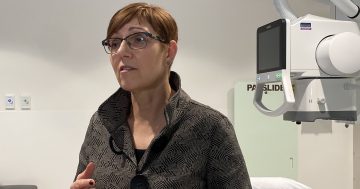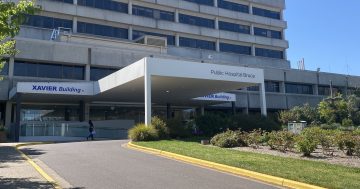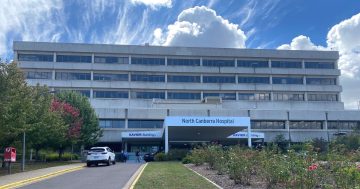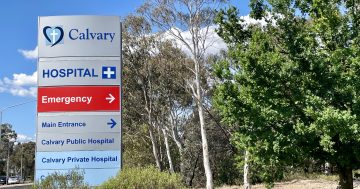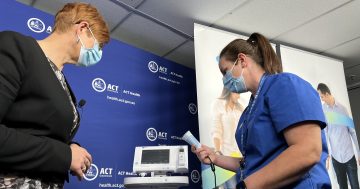
Documents released under Freedom of Information laws have revealed how long people are waiting for outpatient appointments. Photo: Michelle Kroll.
The Liberals have accused the Government of breaking promises over reducing outpatient wait times, with new documents revealing thousands of Canberrans are waiting longer than the clinically recommended time for appointments.
However, the Health Minister has slammed what she has called a “disappointing … lack of understanding” on the part of the Opposition around the wait times, saying outpatient and elective surgery wait times are “not a one-to-one comparison”.
Shadow Health Minister Leanne Castley said a Freedom of Information request for outpatient appointment wait times revealed about 23,065 patients were overdue for their surgery out of a total of 28,472 for certain specialities.
“This means more than 80 per cent of patients are waiting longer than clinically recommended in the ACT,” she said.
“These figures paint a very bleak picture for any Canberran that may need elective surgery in the future as well as the tens of thousands of Canberrans who will have to live in pain and sometimes debilitating conditions until they are admitted.”
The numbers as of March 2022 showed 130 urgent patients waiting an average of 163 days for ear, nose and throat appointments, whereas the clinically recommended time is within 30 days.
There were more than 1300 category 2 patients under the general surgery speciality waiting an average of 575 days for an appointment. The clinically recommended time for semi-urgent appointments is within 90 days.
And while category 3 patients are recommended to be seen within a year, 1250 people under the orthopaedic surgery speciality have been waiting an average of 1085 days.
“Some of these patients have contacted my office and feel forced to pay for private surgeries or move states, because they do not want to live in pain, sometimes for hundreds of days before they receive their surgery,” Ms Castley said.
“It is tragic that Canberrans are forced to take this drastic action because the Barr-Rattenbury Government has failed to address major issues in our public hospitals.”
However, Health Minister Rachel Stephen-Smith said Ms Castley had confused outpatient appointments with surgery, and said some of the specialities rarely even resulted in needing elective surgery.
“For example, dermatology – it’s a very, very important service, but it’s not necessarily highly correlated with the elective surgery waiting list,” she said.
“Of course we’re concerned people are having to wait longer than the recommended time for their outpatient appointment, but it’s also really critical to recognise, though, that not all of those outpatient appointments – when people do see a specialist – are converted to the elective surgery waiting list.”
She said it was important to put the numbers into “context”, as they covered the period when the Delta and Omicron COVID-19 waves were impacting the Territory.
Ms Stephen-Smith said the system currently provided about 130,000 outpatient appointments each year, and this was a “significant improvement”.
“Over the last three years there’s been a reduction in the wait lists, there used to be about 30,000 people who were ‘long waits’ for outpatient appointments,” she said.
“Now we have 30,000 people in total on the wait list.”
Ms Stephen-Smith said other issues impacting the Capital included referrals from NSW, and a heavier reliance on the public outpatient system due to a lack of private specialists working here.
“Where those private specialists are available, the gap payments are significantly more in the ACT,” Ms Stephen-Smith said.
“So you see people who’ve even got private health insurance relying on the public system in a way that they wouldn’t do in Sydney or Melbourne, for example.
“We need to work with the private system to ensure that those people who have private health insurance are able to use [it] without that large gap, freeing up some of that public capacity.”
Canberra Health Services chief operating officer Cathie O’Neill said other strategies being employed to reduce outpatient wait times included more pre-screening work, more Telehealth options for simple follow-up appointments, and encouraging more private practitioners to spend time in public clinics.
“We don’t shy away from that fact [that the times are long], we’ve still got a lot of work to do,” she said.
“For those patients who are waiting, we understand very much that it’s very distressing … we are trying to do the best we can to get as many people seen as possible.”
She said another way to reduce the wait times was for those who had been on the wait list, but had multiple referrals or had already been seen in another jurisdiction, to get in touch.
Ms O’Neill said it varied by speciality, but about 8 per cent of the total outpatient appointments actually weren’t needed anymore.
“If those consumers can let us know, we’ve tried to make it as simple as possible for them to get onto our website or call our central intake, so we can offer those appointments to someone else,” she said.












